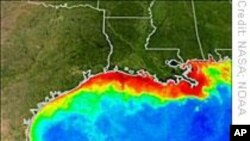At about 400 locations worldwide, agricultural fertilizer and other pollutants flowing into rivers and deltas have created underwater conditions so low in oxygen that aquatic life can't survive. These locations are called dead zones.
In the United States, a new study predicts that the growing demand for biofuels could make it harder to shrink one especially large dead zone off the southern U.S. coast.
Nitrogen fertilizer runoff starts chain reaction
Every growing season, excess nitrogen fertilizer running off croplands in the American Midwest washes into the Mississippi River, and from there, into the Gulf of Mexico. It triggers a biological chain reaction that strips the water of oxygen, killing fish, shrimp, crabs, and other sea life. The dead zone in the Gulf each year grows to about 15,000 square kilometers. The Environmental Protection Agency (EPA) wants to shrink it by two-thirds over the next six years.
Biofuel law is at odds with EPA goal
But the U.S. Congress might have made that goal harder to achieve. In a bid to reduce dependence on foreign oil, Congress passed a law requiring refiners to include more and more biofuels in their gasoline each year, reaching 140 billion liters by 2022. Mike Griffin, a biologist at Carnegie Mellon University, says if farmers grew enough corn and other biofuel crops to meet that target, "Nitrogen loading would actually increase, and we would certainly not be able to meet the goals of the EPA."
Griffin says that Congress's goal of increasing energy independence is obviously at cross purposes with the EPA's goal of shrinking the Gulf of Mexico dead zone, a condition scientists call hypoxia.
"We certainly need to get the people that are doing the hypoxia mitigation strategies and the biofuels strategies together, so that if we are going to go down the road of increasing biofuels that we take these indirect effects of that production into account," he says.
But Griffin says the problem is not just biofuels. He and his colleagues also considered how much nitrogen fertilizer will be used to raise crops to meet growing food demands.
"If we did no biofuels, and we just allowed for food production to increase," he says, "you still can't meet the hypoxia goals in the Gulf of Mexico. You still need to take mitigation actions even if we didn't produce biofuels."
Buffer zones would help, but not solve problem
Griffin says planting buffer zones between crops and rivers or streams is one way to mitigate the fertilizer runoff problem. But his study shows buffer zones alone won't be enough to reach EPA's goal of reducing the dead zone by two-thirds. Other strategies will be needed.
That's partly because agricultural runoff is not the only source of nitrogen pollution. Wastewater, industry and transportation all contribute too and Griffin says steps will need to be taken to reduce their effects as well.
The study was published in the journal Environmental Science and Technology.
News
Biofuels Unravel Efforts to Shrink Gulf Dead Zone

<!-- IMAGE -->





